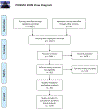American Society for Enhanced Recovery and Perioperative Quality Initiative-4 Joint Consensus Statement on Persistent Postoperative Opioid Use: Definition, Incidence, Risk Factors, and Health Care System Initiatives
- PMID: 30897590
- PMCID: PMC6640123
- DOI: 10.1213/ANE.0000000000003941
American Society for Enhanced Recovery and Perioperative Quality Initiative-4 Joint Consensus Statement on Persistent Postoperative Opioid Use: Definition, Incidence, Risk Factors, and Health Care System Initiatives
Abstract
Persistent postoperative opioid use is thought to contribute to the ongoing opioid epidemic in the United States. However, efforts to study and address the issue have been stymied by the lack of a standard definition, which has also hampered efforts to measure the incidence of and risk factors for persistent postoperative opioid use. The objective of this systematic review is to (1) determine a clinically relevant definition of persistent postoperative opioid use, and (2) characterize its incidence and risk factors for several common surgeries. Our approach leveraged a group of international experts from the Perioperative Quality Initiative-4, a consensus-building conference that included representation from anesthesiology, surgery, and nursing. A search of the medical literature yielded 46 articles addressing persistent postoperative opioid use in adults after arthroplasty, abdominopelvic surgery, spine surgery, thoracic surgery, mastectomy, and thoracic surgery. In opioid-naïve patients, the overall incidence ranged from 2% to 6% based on moderate-level evidence. However, patients who use opioids preoperatively had an incidence of >30%. Preoperative opioid use, depression, factors associated with the diagnosis of substance use disorder, preoperative pain, and tobacco use were reported risk factors. In addition, while anxiety, sex, and psychotropic prescription are associated with persistent postoperative opioid use, these reports are based on lower level evidence. While few articles addressed the health policy or prescriber characteristics that influence persistent postoperative opioid use, efforts to modify prescriber behaviors and health system characteristics are likely to have success in reducing persistent postoperative opioid use.
Conflict of interest statement
Disclosures/Conflict of Interest: None
Figures
Comment in
-
Defining and Reducing the Risk of Persistent Postoperative Opioid Use.Anesth Analg. 2019 Aug;129(2):324-326. doi: 10.1213/ANE.0000000000004193. Anesth Analg. 2019. PMID: 31313668 No abstract available.
References
Publication types
MeSH terms
Substances
Grants and funding
LinkOut - more resources
Full Text Sources
Medical



